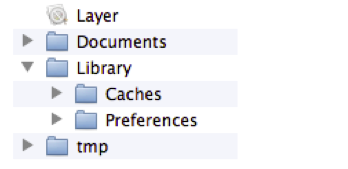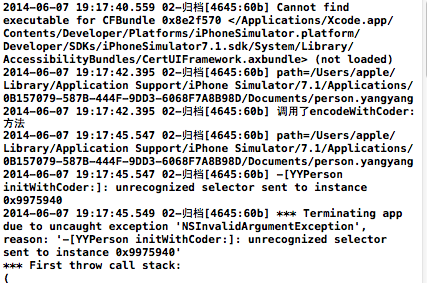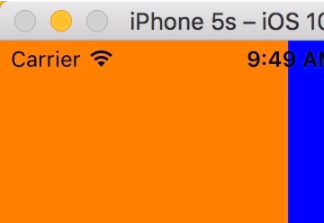xml属性列表-plist
一、应用沙盒
每个ios应用都有⾃己的应⽤沙盒(应用沙盒就是文件系统目录),与其他文件系统隔离。应⽤必须待在⾃己的沙盒里,其他应用不能访问该沙盒(提示:在ios8中已经开放访问)
应⽤沙盒的文件系统⽬录,如下图所示(假设应用的名称叫layer)

模拟器应⽤用沙盒的根路径在: (apple是⽤用户名, 7.0是模拟器版本) /users/apple/library/application support/iphone simulator/7.0/applications
二、应用沙盒结构分析
应⽤程序包:(上图中的layer)包含了所有的资源文件和可执行文件
documents:保存应⽤运行时生成的需要持久化的数据,itunes同步设备时会备份该目录。例如,游戏应用可将游戏存档保存在该目录
tmp:保存应⽤运行时所需的临时数据,使⽤完毕后再将相应的文件从该目录删除。应用没有运行时,系统也可能会清除该目录下的文件。itunes同步设备时 不会备份该目录
library/caches:保存应用运行时⽣成的需要持久化的数据,itunes同步设备时不会备份该目录。⼀一般存储体积大、不需要备份的非重要数据
library/preference:保存应用的所有偏好设置,ios的settings(设置) 应⽤会在该⺫录中查找应⽤的设置信息。itunes同步设备时会备份该目录
三、应用沙盒常见的获取方式
沙盒根目录:nsstring *home = nshomedirectory();
documents:(2种⽅方式)
利用沙盒根目录拼接”documents”字符串
nsstring *home = nshomedirectory();
nsstring *documents = [home stringbyappendingpathcomponent:@"documents"]; // 不建议采用,因为新版本的操作系统可能会修改目录名
利用nssearchpathfordirectoriesindomains函数
// nsuserdomainmask 代表从用户文件夹下找
// yes 代表展开路径中的波浪字符“~”
nsarray *array = nssearchpathfordirectoriesindomains(nsdocumentdirectory, nsuserdomainmask, no); // 在ios中,只有一个目录跟传入的参数匹配,所以这个集合里面只有一个元素
nsstring *documents = [array objectatindex:0];
tmp:nsstring *tmp = nstemporarydirectory();
library/caches:(跟documents类似的2种⽅方法)
利用沙盒根目录拼接”caches”字符串
利⽤nssearchpathfordirectoriesindomains函数(将函数的第2个参数改 为:nscachesdirectory即可)
library/preference:通过nsuserdefaults类存取该目录下的设置信息
相应的代码:
#import "njviewcontroller.h"
#import "njperson.h"
@interface njviewcontroller ()
- (ibaction)savedatabtnclick:(id)sender;
- (ibaction)readdatabtnclick:(id)sender;
@end
@implementation njviewcontroller
/**
* 点击保存按钮
*/
- (ibaction)savedatabtnclick:(id)sender {
// youtube做法
// nsstring *path = @"/users/apple/library/application support/iphone simulator/7.1/applications/a6d53e11-ddf0-4392-b2d4-fe77a96888a6/documents/abc.plist";
// 获取应用程序根目录
nsstring *home = nshomedirectory();
// 不建议写/
//nsstring *path = [home stringbyappendingstring:@"/documents"];
// 不建议documents写死
//nsstring *path = [home stringbyappendingpathcomponent:@"documents"];
// nsuserdomainmask 在用户目录下查找
// yes 代表用户目录的~
// nsdocumentdirectory 查找documents文件夹
// 建议使用如下方法动态获取
nsstring *doc = [nssearchpathfordirectoriesindomains(nsdocumentdirectory, nsuserdomainmask, yes) lastobject];
// 拼接文件路径
nsstring *path = [doc stringbyappendingpathcomponent:@"abc.plist"];
nslog(@"%@", path);
//nsarray *arr = @[@"lnj", @"28"];
//[arr writetofile:path atomically:yes];
// nsdictionary *dict = @{@"name": @"lnj", @"age":@"28"};
// 调用writetofile将数据写入文件
// [dict writetofile:path atomically:yes];
/*
plist只能存储系统自带的一些常规的类, 也就是有writetofile方法的对象才可以使用plist保存数据
字符串/字典/数据/nsnumber/nsdata ...
*/
// 自定义的对象不能保存到plist中
njperson *p = [[njperson alloc] init];
p.name =@"lnj";
nsdictionary *dict = @{@"person": @"abc"};
[dict writetofile:path atomically:yes];
}
/**
* 点击读取按钮
*/
- (ibaction)readdatabtnclick:(id)sender {
nsstring *doc = [nssearchpathfordirectoriesindomains(nsdocumentdirectory, nsuserdomainmask, yes) lastobject];
nsstring *path = [doc stringbyappendingpathcomponent:@"abc.plist"]
;
// 读取数据
nsdictionary *dict = [nsdictionary dictionarywithcontentsoffile:path];
nslog(@"%@", dict);
}
@end
四、属性列表
属性列表是一种xml格式的文件,拓展名为plist
如果对象是nsstring、nsdictionary、nsarray、nsdata、 nsnumber等类型,就可以使用writetofile:atomically:⽅法 直接将对象写到属性列表文件中
nskeydearchiver归档
一、简单说明
在使用plist进行数据存储和读取,只适用于系统自带的一些常用类型才能用,且必须先获取路径相对麻烦;
偏好设置(将所有的东西都保存在同一个文件夹下面,且主要用于存储应用的设置信息)
归档:因为前两者都有一个致命的缺陷,只能存储常用的类型。归档可以实现把自定义的对象存放在文件中。
二、代码示例
1.文件结构

//
// yyviewcontroller.m
// 02-归档
//
// created by apple on 14-6-7.
// copyright (c) 2014年 itcase. all rights reserved.
//
#import "yyviewcontroller.h"
#import "yyperson.h"
@interface yyviewcontroller ()
- (ibaction)savebtnonclick:(id)sender;
- (ibaction)readbtnonclick:(id)sender;
@end
@implementation yyviewcontroller
- (void)viewdidload
{
[super viewdidload];
}
- (ibaction)savebtnonclick:(id)sender {
//1.创建对象
yyperson *p=[[yyperson alloc]init];
p.name=@"文顶顶";
p.age=23;
p.height=1.7;
//2.获取文件路径
nsstring *docpath=[nssearchpathfordirectoriesindomains(nsdocumentdirectory, nsuserdomainmask, yes)lastobject];
nsstring *path=[docpath stringbyappendingpathcomponent:@"person.yangyang"];
nslog(@"path=%@",path);
//3.将自定义的对象保存到文件中
[nskeyedarchiver archiverootobject:p tofile:path];
}
- (ibaction)readbtnonclick:(id)sender {
//1.获取文件路径
nsstring *docpath=[nssearchpathfordirectoriesindomains(nsdocumentdirectory, nsuserdomainmask, yes)lastobject];
nsstring *path=[docpath stringbyappendingpathcomponent:@"person.yangyang"];
nslog(@"path=%@",path);
//2.从文件中读取对象
yyperson *p=[nskeyedunarchiver unarchiveobjectwithfile:path];
nslog(@"%@,%d,%.1f",p.name,p.age,p.height);
}
@end
新建一个person类
yyperson.h文件
//
// yyperson.h
// 02-归档
//
// created by apple on 14-6-7.
// copyright (c) 2014年 itcase. all rights reserved.
//
#import <foundation/foundation.h>
// 如果想将一个自定义对象保存到文件中必须实现nscoding协议
@interface yyperson : nsobject<nscoding>
//姓名
@property(nonatomic,copy)nsstring *name;
//年龄
@property(nonatomic,assign)int age;
//身高
@property(nonatomic,assign)double height;
@end
yyperson.m文件
//
// yyperson.m
// 02-归档
//
// created by apple on 14-6-7.
// copyright (c) 2014年 itcase. all rights reserved.
//
#import "yyperson.h"
@implementation yyperson
// 当将一个自定义对象保存到文件的时候就会调用该方法
// 在该方法中说明如何存储自定义对象的属性
// 也就说在该方法中说清楚存储自定义对象的哪些属性
-(void)encodewithcoder:(nscoder *)acoder
{
nslog(@"调用了encodewithcoder:方法");
[acoder encodeobject:self.name forkey:@"name"];
[acoder encodeinteger:self.age forkey:@"age"];
[acoder encodedouble:self.height forkey:@"height"];
}
// 当从文件中读取一个对象的时候就会调用该方法
// 在该方法中说明如何读取保存在文件中的对象
// 也就是说在该方法中说清楚怎么读取文件中的对象
-(id)initwithcoder:(nscoder *)adecoder
{
nslog(@"调用了initwithcoder:方法");
//注意:在构造方法中需要先初始化父类的方法
if (self=[super init]) {
self.name=[adecoder decodeobjectforkey:@"name"];
self.age=[adecoder decodeintegerforkey:@"age"];
self.height=[adecoder decodedoubleforkey:@"height"];
}
return self;
}
@end
3.打印效果和两个重要的错误提示
点击保存按钮和读取按钮,成功打印结果如下:

关于不实现两个协议方法的错误提示:
-(void)encodewithcoder:(nscoder *)acoder方法:

-(id)initwithcoder:(nscoder *)adecoder方法:

三、继承类中的使用
新建一个学生类,让这个类继承自preson这个类,增加一个体重的属性。
yystudent.h文件
//
// yystudent.h
// 02-归档
//
// created by apple on 14-6-7.
// copyright (c) 2014年 itcase. all rights reserved.
//
#import "yyperson.h"
@interface yystudent : yyperson
//增加一个体重属性
@property(nonatomic,assign) double weight;
@end
yystudent.m文件
//
// yystudent.m
// 02-归档
//
// created by apple on 14-6-7.
// copyright (c) 2014年 itcase. all rights reserved.
//
#import "yystudent.h"
@implementation yystudent
//在子类中重写这两个方法
- (void)encodewithcoder:(nscoder *)acoder
{
[super encodewithcoder:acoder];
nslog(@"调用了yystudent encodewithcoder");
[acoder encodefloat:self.weight forkey:@"weight"];
}
- (id)initwithcoder:(nscoder *)adecoder
{
if (self = [super initwithcoder:adecoder]) {
nslog(@"调用了yystudent initwithcoder");
self.weight = [adecoder decodefloatforkey:@"weight"];
}
return self;
}
@end
yyviewcontroller.m文件
//
// yyviewcontroller.m
// 02-归档
//
// created by apple on 14-6-7.
// copyright (c) 2014年 itcase. all rights reserved.
//
#import "yyviewcontroller.h"
#import "yyperson.h"
#import "yystudent.h"
@interface yyviewcontroller ()
- (ibaction)savebtnonclick:(id)sender;
- (ibaction)readbtnonclick:(id)sender;
@end
@implementation yyviewcontroller
- (void)viewdidload
{
[super viewdidload];
}
- (ibaction)savebtnonclick:(id)sender {
//1.创建对象
// yyperson *p=[[yyperson alloc]init];
// p.name=@"文顶顶";
// p.age=23;
// p.height=1.7;
yystudent *s=[[yystudent alloc]init];
s.name=@"wendingding";
s.age=23;
s.height=1.7;
s.weight=62;
//2.获取文件路径
nsstring *docpath=[nssearchpathfordirectoriesindomains(nsdocumentdirectory, nsuserdomainmask, yes)lastobject];
nsstring *path=[docpath stringbyappendingpathcomponent:@"person.yangyang"];
nslog(@"path=%@",path);
//3.将自定义的对象保存到文件中
// [nskeyedarchiver archiverootobject:p tofile:path];
[nskeyedarchiver archiverootobject:s tofile:path];
}
- (ibaction)readbtnonclick:(id)sender {
//1.获取文件路径
nsstring *docpath=[nssearchpathfordirectoriesindomains(nsdocumentdirectory, nsuserdomainmask, yes)lastobject];
nsstring *path=[docpath stringbyappendingpathcomponent:@"person.yangyang"];
nslog(@"path=%@",path);
//2.从文件中读取对象
// yyperson *p=[nskeyedunarchiver unarchiveobjectwithfile:path];
// nslog(@"%@,%d,%.1f",p.name,p.age,p.height);
yystudent *s=[nskeyedunarchiver unarchiveobjectwithfile:path];
nslog(@"%@,%d,%.1f,%f",s.name,s.age,s.height,s.weight);
}
@end
点击保存按钮和读取按钮后的打印输出:

四、重要说明
1.保存数据过程:
//1.创建对象
yystudent *s=[[yystudent alloc]init];
s.name=@"wendingding";
s.age=23;
s.height=1.7;
s.weight=62;
//2.获取文件路径
nsstring *docpath=[nssearchpathfordirectoriesindomains(nsdocumentdirectory, nsuserdomainmask, yes)lastobject];
nsstring *path=[docpath stringbyappendingpathcomponent:@"person.yangyang"];
nslog(@"path=%@",path);
//3.将自定义的对象保存到文件中
[nskeyedarchiver archiverootobject:s tofile:path];
2.读取数据过程:
//1.获取文件路径
nsstring *docpath=[nssearchpathfordirectoriesindomains(nsdocumentdirectory, nsuserdomainmask, yes)lastobject];
nsstring *path=[docpath stringbyappendingpathcomponent:@"person.yangyang"];
//2.从文件中读取对象
yystudent *s=[nskeyedunarchiver unarchiveobjectwithfile:path];
3.遵守nscoding协议,并实现该协议中的两个方法。
4.如果是继承,则子类一定要重写那两个方法。因为person的子类在存取的时候,会去子类中去找调用的方法,没找到那么它就去父类中找,所以最后保存和读取的时候新增加的属性会被忽略。需要先调用父类的方法,先初始化父类的,再初始化子类的。
5.保存数据的文件的后缀名可以随意命名。
6.通过plist保存的数据是直接显示的,不安全。通过归档方法保存的数据在文件中打开是乱码的,更安全。


















